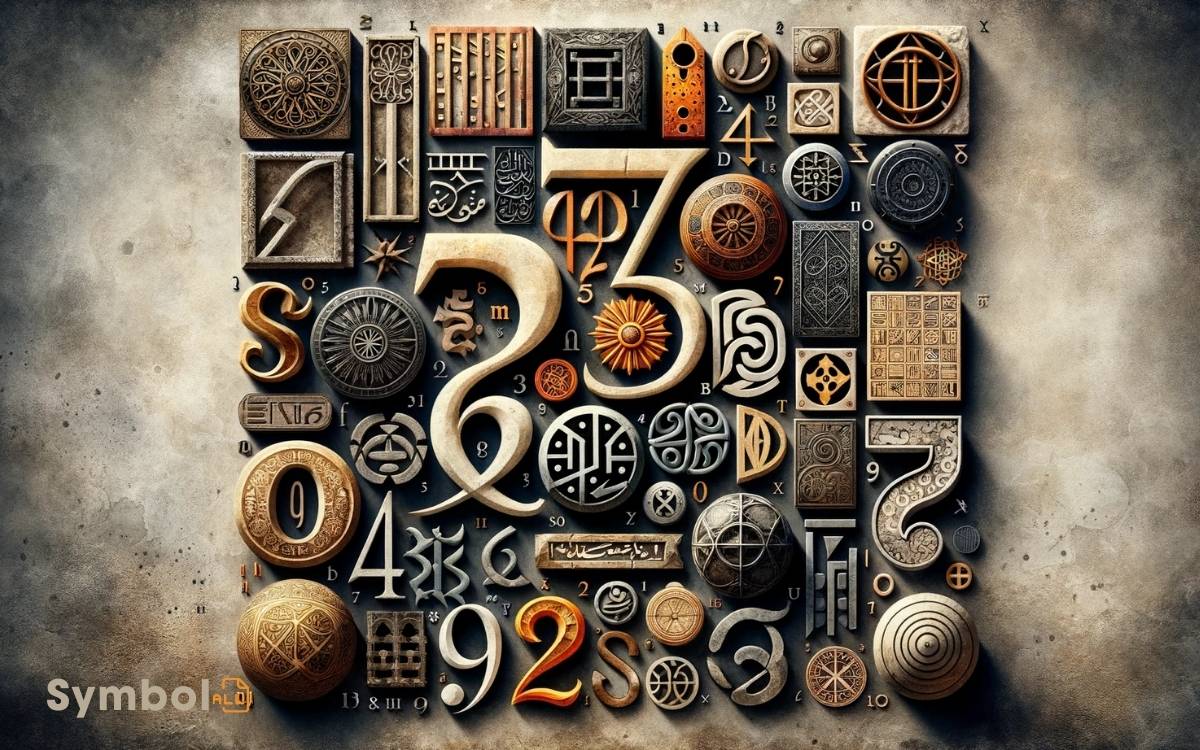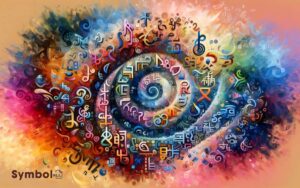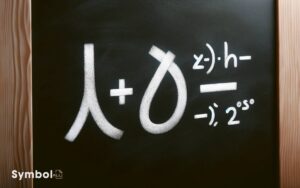A Symbol Used to Represent a Number: Arabic Numerals!
A symbol used to represent a number isn’t just a mark; it’s a key player in the grand arena of mathematics and communication. From ancient hieroglyphs to the sleek digits of Arabic numerals, each symbol carries a legacy of innovation and practical necessity.
You’re using a system that has evolved from the ingenious minds of the Sumerians, Egyptians, and Indians, all of whom contributed foundational elements like the decimal system, the concept of zero, and positional value.
These symbols offer clarity in conveying complex ideas, seamlessly integrating with technology to power computations worldwide. Grasping their origins and uses opens up a world where numbers shape reality.

Key Takeaways
The Origins of Numerals
The origins of numerals, pivotal to the development of mathematics and communication, trace back to various ancient civilizations that innovatively created systems to represent numbers.
These early numerals were more than mere symbols; they were the foundation of complex mathematical concepts and facilitated trade, astronomy, and architecture.
Ancient Sumerians introduced the first known numeric system around 3400 BC, employing a base-60 structure, whereas Egyptians utilized a decimal system based on hieroglyphs for counting and measuring.
Through analytical examination, you’ll recognize that each civilization’s approach to numerology was influenced by practical needs and environmental factors.
This resulted in a diverse range of numeric systems, each with unique characteristics yet contributing collectively to the evolution of numerical representation.
Understanding these origins is essential for appreciating the numerical systems that shape our current mathematical understanding.
Understanding Decimal System
As you explore the decimal system, you’ll grasp how it’s a cornerstone of modern mathematics, structured around the base-ten system.
Understanding decimal place value is critical, as it dictates the position and value of each digit in a number.
This knowledge enables precise calculations and a deeper comprehension of numerical representations.
Decimal System Basics
Nearly every modern numerical system is based on the decimal system, a method that employs base 10 to represent any number using ten fundamental digits from 0 to 9.
This base-10 structure underpins most global numerical and monetary systems, making it universally integral. You’ll find its application spans from everyday calculations to complex scientific computations.
Understanding the decimal system’s basics isn’t just about recognizing these ten digits but also about grasping their role in representing quantities in a systematic, coherent manner.
Each digit’s value is determined by its position, but exploring that concept falls under another discussion.
For now, recognize that these digits can combine in infinite ways to depict any conceivable number, showcasing the decimal system’s versatility and foundational role in mathematics and beyond.
Decimal Place Value
Understanding the decimal system further, you’ll often find that the value of each digit considerably changes based on its position, a concept known as decimal place value. This positional system allows for the precise representation of numbers, both large and small.
Consider the number 132.478:
- Ones Place (132.478): The digit 2 represents 2 ones, or simply 2.
- Tenths Place (132.478): The digit 4, immediately after the decimal point, signifies 4 tenths or 0.4.
- Hundredths Place (132.478): The digit 7 indicates 7 hundredths, equating to 0.07.
Each position, moving from left to right, decreases in value by a factor of ten. This systematic decrease enables the decimal system to accurately represent fractions and whole numbers through a unified framework.
Roman Numerals Unveiled
You’ve explored the decimal system; now, let’s turn your attention to Roman numerals. Understanding their basic rules will clarify how these ancient symbols represent numbers today.
We’ll also examine their modern usage and provide examples to illustrate their continued relevance.
Basic Roman Numeral Rules
Why do Roman numerals, ancient symbols representing numbers, still captivate our modern minds? It’s their unique blend of simplicity and complexity that intrigues.
To grasp their essence, let’s explore the basic rules:
- Repeatable Symbols: Letters like I, X, C, and M can be repeated up to three times to form numbers. For instance, III equals 3.
- Subtractive Principle: When a smaller numeral precedes a larger one, it’s subtracted. IV means 4, not 6.
- Additive Principle: Conversely, when a smaller numeral follows a larger one, their values are added. VI equals 6.
Understanding these rules provides a foundation for deciphering and appreciating the elegance of Roman numerals. Their logic, once demystified, reveals a methodical system of representation.
Modern Usage and Examples
Despite their ancient origins, we frequently encounter Roman numerals in various modern contexts, from clock faces to movie sequels.
You’ll see them marking chapters in books, denoting monarchs or popes with the same name, and even in the annual Super Bowl. This usage underscores their enduring appeal and functionality.
When you watch a movie sequel, the title might read ‘Part II’ instead of ‘Part 2’, offering a touch of gravitas. On your watch, Roman numerals replace the usual digits, blending tradition with modernity. In sporting events like the Super Bowl, they lend a sense of legacy and grandeur.
Each of these examples showcases how Roman numerals serve not just as a method of counting, but as a bridge connecting the past with the present.
The Elegance of Arabic Numbers
Arabic numbers often captivate with their simplicity and functional elegance, embodying a refined mathematical beauty that appeals universally.
These numerals, ranging from 0 to 9, serve as the foundation for complex mathematical operations and concepts, demonstrating their inherent versatility. These whole number writing symbols are not only integral to basic counting but also play a critical role in representing higher numerical values through place value systems. By combining these digits in various arrangements, we unlock the ability to perform advanced calculations and model real-world phenomena. This simple set of symbols thus forms the backbone of various disciplines, from science and engineering to finance and technology.
Consider the following points:
- Universality: Arabic numbers are recognized and used worldwide, facilitating global communication and commerce.
- Decimal System: Their use in the decimal system allows for easy calculation and representation of large numbers, enhancing computational efficiency.
- Adaptability: They seamlessly integrate with technology, ensuring their relevance in digital and analog formats.
This numerical system’s logical structure supports a wide range of mathematical functions, from basic arithmetic to advanced scientific calculations, reflecting its indispensable role in modern society.
Its elegance lies not just in form, but in its capability to convey complex ideas with clarity and precision.
Binary Code: A Digital Language
As you delve into the domain of numbers and symbols, it’s essential to comprehend binary code, the fundamental digital language. This language, consisting of only two symbols, 0 and 1, plays a vital role in computing history and the interpretation of digital messages.
Basics of Binary Code
How does a system based solely on the digits 0 and 1 manage to represent complex information in the digital world? Binary code, at its core, relies on a binary system where these two numbers serve as symbols to encode data.
This simplicity allows for:
- Efficiency: Binary code requires minimal data to represent information, enhancing computational speed and storage efficiency.
- Reliability: With only two states (on/off or 0/1), binary reduces the chance of error in data transmission and processing.
- Versatility: It can encode anything from simple numbers to complex multimedia content.
Binary in Computing History
Binary code, a foundational element of modern computing, has evolved dramatically since its inception, shaping the way we interact with digital technology.
Initially, its application was theoretical, serving as a mathematical curiosity. However, with the advent of electronic computers in the 20th century, binary code’s potential was fully realized.
It became the core language through which computers operate, turning abstract switches into complex algorithms and applications.
You must understand that binary’s simplicity, based on just two symbols, 0 and 1, allowed for the rapid development and miniaturization of computing devices. This evolution sparked a digital revolution, transforming not just computing machinery but society’s entire fabric.
Binary code’s influence extends beyond mere data processing, underpinning the digital communication, storage, and retrieval systems that you rely on daily.
Decoding Binary Messages
Understanding how to decode binary messages reveals the ability to interpret the digital language that underpins computing and communication technologies. Binary code, composed of ones and zeros, operates as the fundamental building block for digital devices.
Here’s how you can start exploring these messages:
- Identify Binary Sequences: Recognize the 8-bit segments that represent individual characters in the ASCII table.
- Convert Binary to Decimal: Use the position of each digit to calculate its value, with each position representing a power of 2.
- Translate to Characters: Match the decimal numbers to corresponding characters in the ASCII table.
This process, though seemingly complex, is logical and systematic. By mastering it, you investigate further into the mechanics of digital communication, enhancing your understanding and appreciation of modern technology’s foundation.
Ancient Egyptian Hieroglyphics
Delving into Ancient Egyptian hieroglyphics reveals a complex system where symbols intricately represented numbers, offering insights into the civilization’s mathematical understanding.
You’ll find that each symbol served a unique purpose, enabling Egyptians to perform calculations and maintain records with precision.
Here’s a glimpse into their numerical system:
| Symbol | Value |
|---|---|
| 𓏺 | 1 |
| 𓎆 | 10 |
| 𓍢 | 100 |
| 𓆼 | 1,000 |
| 𓂭 | 10,000 |
This table illustrates the logical progression of values, showcasing how Egyptians built larger numbers by repeating symbols. Their approach to mathematics was both practical and sophisticated, reflecting a deep understanding of quantity and numerical relationships.
By studying these symbols, you gain a window into the ancient mindset, appreciating their ability to convey complex ideas through simple, yet powerful, representations.
Mathematics of the Mayans
The Mayans, with their sophisticated understanding of mathematics, developed a system that was remarkably advanced for its time. This system was based on vigesimal (base-20), a stark contrast to the base-10 system prevalent today.
Here’s how it stood out:
- Zero Concept: They were among the first to use a symbol for zero, an innovation that greatly enhanced their numerical system’s flexibility and complexity.
- Place Values: Utilizing a positional value system allowed them to express very large numbers efficiently, a necessity for their extensive calendrical calculations and astronomical observations.
- Symbols: Only three symbols (a dot for one, a bar for five, and a shell-like symbol for zero) facilitated their arithmetic operations, demonstrating a remarkable economy of notation.
This analytical approach underlines the Mayans’ deep understanding of mathematics, showcasing their ability to abstract and innovate, laying foundational concepts that resonate in modern mathematics.
The Chinese Counting System
Moving from the mathematical innovations of the Mayans, let’s examine the Chinese counting system, noted for its unique approach and historical significance.
Unlike the positional systems you might be familiar with, the Chinese system employs characters for numbers and uses a base-10 (decimal) structure.
This means every new position represents a power of ten: ten, hundred, thousand, and so on. You’ll find this remarkably efficient for calculation and recording large numbers.
Additionally, the system’s simplicity and versatility have allowed it to endure and evolve over millennia, integrating seamlessly into daily life and commerce.
Its impact extends beyond mathematics, influencing language and cultural practices. Understanding this system gives you insight into not just the mechanics of Chinese numeration but also the broader implications of how numbers shape societies.
Indian Numeration Influence
Exploring the domain of numeration, understanding how Indian numeration has significantly influenced mathematical systems worldwide is crucial.
The impact of Indian numeration is profound, reshaping the trajectory of mathematical history through several critical contributions:
- Introduction of Zero: India’s conceptualization of zero as a number transformed mathematics, enabling the development of an effective positional numeral system.
- Decimal System: The Indian numeral system is based on ten distinct symbols (including zero), establishing the groundwork for the modern decimal system.
- Place Value System: Indian mathematicians introduced the place value concept, which is essential for comprehending large numbers and carrying out arithmetic operations efficiently.
These contributions haven’t only improved mathematical computation but have also promoted the global exchange of mathematical ideas, highlighting the enduring legacy of Indian numeration.
Greek Contributions to Mathematics
Often, Greek contributions to mathematics have profoundly shaped our understanding of geometry, algebra, and mathematical logic. You’ll find that the Greeks were pioneers in exploring the concepts of proof and deduction, establishing the groundwork for modern mathematics.
They investigated geometry with an unparalleled depth, evidenced by Euclid’s ‘Elements,’ which has served as a foundational text for over two millennia.
Through rigorous logical reasoning, they introduced the concept of mathematical proof, transforming mathematics from a set of empirical observations into a deductive science.
Their work on the properties of numbers, particularly prime numbers, and the introduction of mathematical abstraction, has had a lasting impact. The Greeks didn’t just contribute theories; they provided a way of thinking that underpins the very structure of modern mathematics.
Evolution of Numerical Representation
Throughout history, humans have developed various symbols to represent numbers, reflecting a significant evolution in understanding and utilizing mathematical concepts. This progression has significantly shaped how you perceive and interact with the quantitative aspects of the world.
- Primitive Counting Systems: Initially, tally marks and natural objects served as the earliest numerical symbols, enabling basic counting and trade.
- Development of Numerals: Cultures like the Egyptians and Romans introduced more sophisticated symbols hieroglyphs and numerals, respectively. These systems allowed for more complex calculations and record-keeping.
- Introduction of Zero and Place Value: The concept of zero and the place value system, developed by ancient Indian mathematicians, revolutionized numerical representation, laying the groundwork for modern mathematics.
This evolution underscores the dynamic nature of mathematical symbols, adapting to meet the growing demands of complexity and precision in numerical operations.
Conclusion
In sum, you’ve journeyed through the evolution of numerical representation, from ancient symbols to the binary code of the digital age. Each system, be it Roman, Arabic, or Binary, offers a unique lens to view and understand the vast world of numbers.
Your grasp of these numerals not only connects you to historical civilizations but also equips you with the precision needed in today’s digital era. Consequently, numbers, in their various forms, are more than mere symbols; they’re the universal language of logic and reason.






